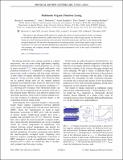Files in this item
Multimode organic polariton lasing
Item metadata
| dc.contributor.author | Arnardottir, Kristin B. | |
| dc.contributor.author | Moilanen, Antti J. | |
| dc.contributor.author | Strashko, Artem | |
| dc.contributor.author | Törmä, Päivi | |
| dc.contributor.author | Keeling, Jonathan | |
| dc.date.accessioned | 2020-12-07T15:58:11Z | |
| dc.date.available | 2020-12-07T15:58:11Z | |
| dc.date.issued | 2020-12-04 | |
| dc.identifier | 271013578 | |
| dc.identifier | 71230b23-e41a-4b29-85cd-54c46693b9b6 | |
| dc.identifier | 000595171000017 | |
| dc.identifier | 85097585204 | |
| dc.identifier.citation | Arnardottir , K B , Moilanen , A J , Strashko , A , Törmä , P & Keeling , J 2020 , ' Multimode organic polariton lasing ' , Physical Review Letters , vol. 125 , no. 23 , 233603 . https://doi.org/10.1103/PhysRevLett.125.233603 | en |
| dc.identifier.issn | 0031-9007 | |
| dc.identifier.other | ArXiv: http://arxiv.org/abs/2004.06679v1 | |
| dc.identifier.other | ORCID: /0000-0002-4283-552X/work/84753170 | |
| dc.identifier.other | ORCID: /0000-0001-8082-1826/work/84753326 | |
| dc.identifier.other | ORCID: /0000-0002-6624-2307/work/84753420 | |
| dc.identifier.uri | https://hdl.handle.net/10023/21093 | |
| dc.description | Funding: KBA and JK acknowledge financial support from EPSRC program “Hybrid Polaritonics” (EP/M025330/1). AJM and PT acknowledge support by the Academy of Finland under project numbers 303351, 307419, 327293, 318987 (QuantERA project RouTe) and 318937 (PROFI), and by Centre for Quantum Engineering (CQE) at Aalto University. AJM acknowledges financial support by the Jenny and Antti Wihuri Foundation. AS acknowledges support from the EPSRC CM-CDT (EP/L015110/1). | en |
| dc.description.abstract | We present a beyond-mean-field approach to predict the nature of organic polariton lasing, accounting for all relevant photon modes in a planar microcavity. Starting from a microscopic picture, we show how lasing can switch between polaritonic states resonant with the maximal gain, and those at the bottom of the polariton dispersion. We show how the population of nonlasing modes can be found, and by using two-time correlations, we show how the photoluminescence spectrum (of both lasing and nonlasing modes) evolves with pumping and coupling strength, confirming recent experimental work on the origin of blueshift for polariton lasing. | |
| dc.format.extent | 7 | |
| dc.format.extent | 551546 | |
| dc.language.iso | eng | |
| dc.relation.ispartof | Physical Review Letters | en |
| dc.subject | QC Physics | en |
| dc.subject | TK Electrical engineering. Electronics Nuclear engineering | en |
| dc.subject | DAS | en |
| dc.subject.lcc | QC | en |
| dc.subject.lcc | TK | en |
| dc.title | Multimode organic polariton lasing | en |
| dc.type | Journal article | en |
| dc.contributor.sponsor | EPSRC | en |
| dc.contributor.institution | University of St Andrews. School of Physics and Astronomy | en |
| dc.contributor.institution | University of St Andrews. Condensed Matter Physics | en |
| dc.identifier.doi | https://doi.org/10.1103/PhysRevLett.125.233603 | |
| dc.description.status | Peer reviewed | en |
| dc.identifier.url | https://journals.aps.org/prl/abstract/10.1103/PhysRevLett.125.233603 | en |
| dc.identifier.grantnumber | EP/M025330/1 | en |
This item appears in the following Collection(s)
Items in the St Andrews Research Repository are protected by copyright, with all rights reserved, unless otherwise indicated.

